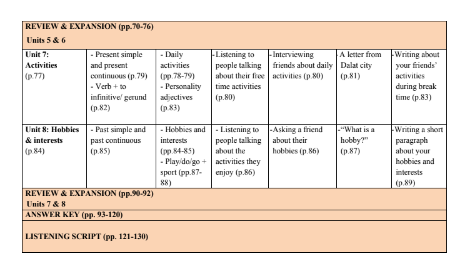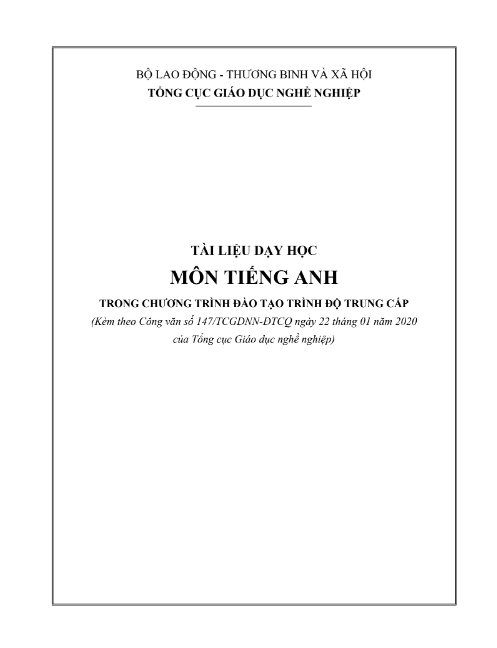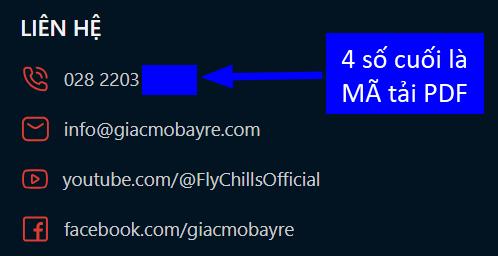


MỤC LỤC
Unit 1: Family and friends (p.7)
- Grammar:
Be, possessive adjectives (p.8–9)
Present simple (p.14–15) - Vocabulary: Jobs (p.10–11)
- Listening: Listening to people talking about themselves and their families (p.11–12)
- Speaking: Talking about yourself (p.12–13)
- Reading: “My friend Nika” (p.13–14)
- Writing: Writing a short paragraph about yourself (p.16)
Unit 2: Leisure time (p.17)
- Grammar: Adverbs of frequency (p.18–19), Can/Can’t (p.21)
- Vocabulary: Sports and free-time activities (p.19–21)
- Listening: Listening to people talking about their hobbies (p.22–23)
- Speaking: Interviewing friends about their hobbies (p.20–21)
- Reading: “What does she usually do on Saturdays?” (p.21–22)
- Writing: Writing about an activity you enjoy (p.24)
REVIEW & EXPANSION (pp.25–28)
Unit 3: Places (p.29)
- Grammar: There is/are and prepositions of places (pp.30–31)
- Vocabulary: Places in a city – word groups (pp.29–31); Things in a house (pp.38–39)
- Listening: Listening to people talking about items in a house (pp.33–34)
- Speaking: Interviewing friends about places (pp.35–36)
- Reading: “Da Nang City – a worthwhile city in Vietnam” (pp.37–38)
- Writing: Writing a paragraph describing your city (p.39)
Unit 4: Food and drink (p.40)
- Grammar: Countable and uncountable nouns (pp.41–42), Should/Shouldn’t (pp.47–48)
- Vocabulary: Food and drink (pp.40–41)
- Listening: Listening to people talking about foods and drinks they like (p.43)
- Speaking: Asking friends about foods and drinks they like (p.43)
- Reading: A menu at a restaurant (pp.46–47)
- Writing: Writing a short paragraph about your friend and what he/she should do and shouldn’t do to be healthy (p.48)
REVIEW & EXPANSION (pp.49–51)
Unit 5: Special occasions (p.52)
- Grammar: Present continuous (p.54); Present simple & Present continuous (p.57)
- Vocabulary: Adjectives of appearance (p.52); Clothes and colours (p.58)
- Listening: Listening to people talking about activities in a Vietnamese diary (pp.54–55)
- Speaking: Asking friends about their special days (pp.55–56)
- Reading: “Tet in Vietnam” (p.56)
- Writing: Writing a short paragraph about your special event that you want to share with friends (p.59)
Unit 6: Vacation (p.60)
- Grammar: Past simple of to be (pp.62–63); Past simple – regular and irregular verbs (pp.66–67)
- Vocabulary: Vacation activities (pp.64–65); Vacation items (p.68)
- Listening: Listening to people talking about their holiday trips (p.63)
- Speaking: Asking friends about vacations (p.64)
- Reading: “My first trip to Ha Long Bay” (p.68)
- Writing: Writing a short paragraph about your last vacation (p.69)
REVIEW & EXPANSION (pp.70–76)
Unit 7: Activities (p.77)
- Grammar: Present simple and present continuous (p.79); Verb + to infinitive/gerund (p.82)
- Vocabulary: Daily activities (pp.78–79); Personality adjectives (p.83)
- Listening: Listening to people talking about their free activities (p.80)
- Speaking: Interviewing friends about daily activities (p.80)
- Reading: “A letter from Dalat City” (p.81)
- Writing: Writing about your friends’ activities during break time (p.83)
Unit 8: Hobbies & interests (p.84)
- Grammar: Past simple and past continuous (p.85)
- Vocabulary: Hobbies – interests (pp.84–85); Play/do/go + sport (p.87)
- Listening: Listening to people talking about the activities they enjoy (p.86)
- Speaking: Asking a friend about their hobbies (p.86)
- Reading: “What is a hobby?” (p.87)
- Writing: Writing a short paragraph about your hobbies/interests (p.89)
REVIEW & EXPANSION (pp.90–92)
Units 7 & 8
ANSWER KEY (pp.93–120)
LISTENING SCRIPT (pp.121–130)
LỜI GIỚI THIỆU
Tài liệu dạy học môn Tiếng Anh trong chương trình đào tạo trình độ trung cấp bao gồm 08 đơn vị bài học (unit).
Mỗi đơn vị bài học gồm các phần sau:
- Warm up:
Giúp người học thực hành kỹ năng nói theo cặp và theo nhóm thông qua tranh ảnh để tăng hứng thú vào bài học thông qua các hoạt động như introduce yourself to your classmates, mô tả các bức tranh với bạn bè. - Vocabulary:
Giúp người học củng cố từ vựng theo từng chủ đề một cách sinh động thông qua các hoạt động hỏi và trả lời câu hỏi, nối từ với hình, phân loại danh từ, v.v. - Grammar focus:
Giúp người học thực hành các cấu điểm ngữ pháp thông qua các dạng bài tập đa dạng như hoàn chỉnh câu, đặt câu hỏi, viết lại câu, hoàn chỉnh bảng, v.v. - Listening:
Người học nghe các đoạn hội thoại và chọn câu trả lời đúng, nghe để điền từ, hoặc nghe để trả lời câu hỏi. - Speaking:
Giúp người học luyện kỹ năng nói thông qua hội thoại, phỏng vấn bạn bè hoặc miêu tả bản thân, gia đình, công việc, sở thích…
LISTENING
A. Listen and read the dialogue.
Alex: This is your album, isn’t it?
Carey: Yes, certainly.
Alex: Can I look at it? I really like looking at photos.
Carey: Sure. They’re from my grandpa’s birthday party. He’s 85 years old.
Alex: Oh! He looks really fantastic at his age.
Carey: Yes, he’s fine, but he has to walk with a stick.
Alex: And who’s next to your grandpa?
Carey: That’s my uncle Peter. He loves playing tennis.
Alex: Oh yes. And who’s that?
Carey: That’s my cousin Mary. I’m not really into her.
Alex: Why not?
Carey: I don’t know. She’s so wonderful. She can speak 3 languages and play the piano.
Alex: I understand. Do you like meeting up with all your family members?
Carey: Yes, I do.
Alex: And how about your parents?
Carey: They like it, too. As long as the party isn’t at my house.
B. Circle T (TRUE) or F (FALSE) for the sentences below.
- Carey loves looking at photos. T F
- Carey’s grandpa is 80. T F
- Carey’s grandpa can’t walk without a stick. T F
- Carey’s uncle isn’t interested in tennis. T F
- Mary can speak 3 languages. T F
- Carey likes Mary. T F
- Carey doesn’t like family meetings. T F
- Carey’s parents like to meet family members at home. T F
C. Listen to what Anna says about her family and answer the following questions.
- How many sisters does Anna have?
- How many cousins does Anna have?
- How old is Anna’s mother?
- What is Anna’s uncle’s name?
- Who does she like best in her family?
D. Answer the questions about yourself.
- What are your mother’s and father’s names?
- How many brothers and sisters do you have?
- How many cousins do you have?
- Do you have any aunts and uncles?
- How old are your grandparents?
- Who is your favourite person?
SPEAKING
A. Fill the gaps with your information and then introduce yourself to a partner and take turns making conversations.
All about me
My name is _______________________________.
I study
- English
- History
- Modern languages
- Art
- Music
- Other: _____________________
Do you enjoy it?
- Yes, it’s fun.
- It’s OK, I guess.
- Not really.
I live __________________________.
- in a dormitory
- with friends
- on campus
- with my family
- in an apartment
I work ___________________________.
- in a convenience store
- in a grocery store
- I don’t have a job
- in a restaurant
- in an office
- as a tutor
- as a pizza delivery driver
- Other: _______________________
Student A: Hello, what’s your name?
Student B: My name is Somchai. I study Art.
READING
My friend Minh
My friend’s name is Minh. Minh is from Ho Chi Minh city, in Vietnam. He is Vietnamese. He is married and has two children. His wife, Jane, is American. She is from Boston, in the United States. Her family is still in Boston, but she now works and lives with Minh in France. They speak English, French and Vietnamese.
Their children are pupils at a local primary school. The children go to school with other children from all over the world. Rose, their daughter, has friends from France, Switzerland, and Austria. Jack, their son, goes to school with students from South Africa, Spain, and Canada.
A. Read the text and choose the correct option a, b, c, or d.
- Where is Minh from?
a. France b. Vietnam c. Spain d. Canada - Where is his wife from?
a. New York b. Switzerland c. Boston d. France - Where are they now?
a. Spain b. Boston c. France d. Sweden - Where is Jane’s family?
a. United States b. England c. Canada d. Vietnam - How many languages does his family speak?
a. 2 b. 3 c. 4 d. 5 - What are the children’s names?
a. Minh and Jane b. Jane and Jack c. Rose and Jack d. Rose and Minh - The school is
a. international b. big c. small d. difficult



